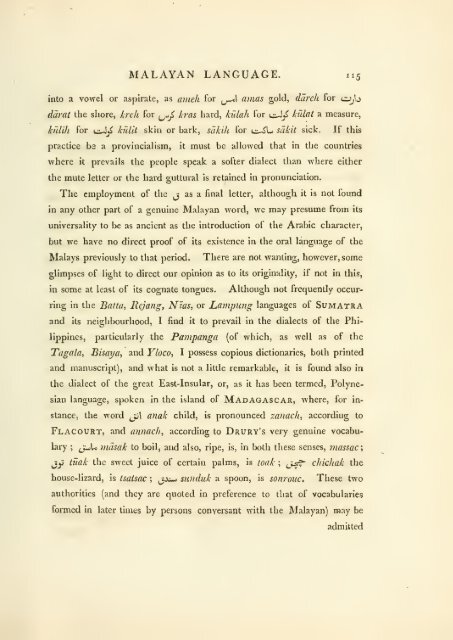A grammar of the Malayan language, with an introduction and praxis..
A grammar of the Malayan language, with an introduction and praxis..
A grammar of the Malayan language, with an introduction and praxis..
Create successful ePaper yourself
Turn your PDF publications into a flip-book with our unique Google optimized e-Paper software.
MALAYAN LANGUAGE. 115<br />
into a vowel or aspirate, as ameh for ^j^\ amas gold, dareh for ci^b<br />
darat <strong>the</strong> shore, kick for ^^<br />
h'as hard, kulah for li^J^ ^w/fff a measure,<br />
kiilih for i^j^ A'?7//i skin or bark, sakili for l^-^L sdkit sick. If this<br />
practice be a provincialism, it must be allowed that in <strong>the</strong> countries<br />
where it prevails <strong>the</strong> people speak a s<strong>of</strong>ter dialect th<strong>an</strong> where ei<strong>the</strong>r<br />
<strong>the</strong> mute letter or <strong>the</strong> hard guttural is retained in pronunciation.<br />
The employment <strong>of</strong> <strong>the</strong> j<br />
as a final letter, although it is not found<br />
in <strong>an</strong>y o<strong>the</strong>r part <strong>of</strong> a genuine <strong>Malay<strong>an</strong></strong> word, we may presume from its<br />
universality to be as <strong>an</strong>cient as <strong>the</strong> <strong>introduction</strong> <strong>of</strong> <strong>the</strong> Arabic character,<br />
but we have no direct pro<strong>of</strong> <strong>of</strong> its existence in <strong>the</strong> oral <strong>l<strong>an</strong>guage</strong> <strong>of</strong> <strong>the</strong><br />
Malays previously to that period. There are not w<strong>an</strong>ting, however, some<br />
glimpses <strong>of</strong> light to direct our opinion as to its originality, if not in this,<br />
in some at least <strong>of</strong> its cognate tongues. Although not frequently occur-<br />
ring in <strong>the</strong> Batta, Rej<strong>an</strong>g, Nias, or La7npimg <strong>l<strong>an</strong>guage</strong>s <strong>of</strong> Sumatra<br />
<strong>an</strong>d its neighbourhood, I find it to prevail in <strong>the</strong> dialects <strong>of</strong> <strong>the</strong> Phi-<br />
lippines, particularly <strong>the</strong> Pmnp<strong>an</strong>ga (<strong>of</strong> which, as well as <strong>of</strong> <strong>the</strong><br />
Tagala, Bisaya, <strong>an</strong>d Yloco, I possess copious dictionaries, both printed<br />
<strong>an</strong>d m<strong>an</strong>uscript), <strong>an</strong>d what is not a little remarkable, it is found also in<br />
<strong>the</strong> dialect <strong>of</strong> <strong>the</strong> great East-Insular, or, as it has been termed, Polyne-<br />
si<strong>an</strong> <strong>l<strong>an</strong>guage</strong>, spoken in <strong>the</strong> isl<strong>an</strong>d <strong>of</strong> Madagascar, where, for in-<br />
st<strong>an</strong>ce, <strong>the</strong> word ^p\ <strong>an</strong>ak child, is pronounced z<strong>an</strong>ach, according to<br />
Flacourt, <strong>an</strong>d <strong>an</strong>nach, according to Drury's very genuine vocabu-<br />
lary ; fjJ^ nidsak to boil, <strong>an</strong>d also, ripe, is, in both <strong>the</strong>se senses, massac,<br />
jy ttiak <strong>the</strong> sweet juice <strong>of</strong> certain palms, is toak ; ^j^ clikhak <strong>the</strong><br />
house-lizard, is tsatsac ; jjc~j sunduk a spoon, is sonrouc. These two<br />
authorities (<strong>an</strong>d <strong>the</strong>y are quoted in preference to that <strong>of</strong> vocabularies<br />
formed in later times by persons convers<strong>an</strong>t <strong>with</strong> <strong>the</strong> <strong>Malay<strong>an</strong></strong>) may be<br />
admitted

















